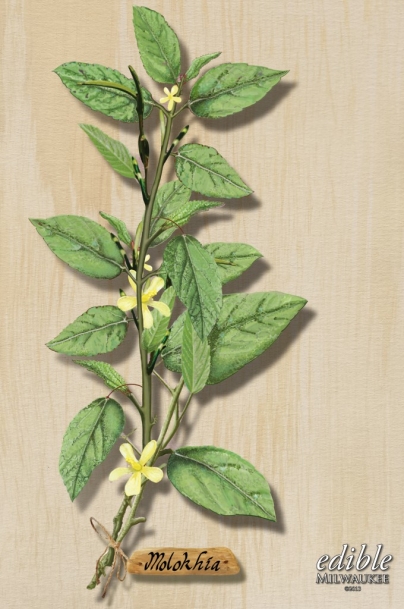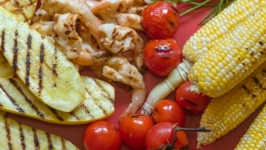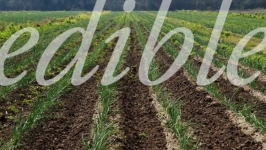Ordinary and Extraordinary: Ancient Green from an Antique Land
“The pepper trade was responsible for the deaths of thousands of people, the enslavement of countless others, the establishment of the opium trade in India and the extinction of the dodo.”
Earlier this year, the Chicago Tribune’s William Hageman wrote the above statement in a short book teaser for Marjorie Shaffer’s “Pepper: A History of the World’s Most Influential Spice,” summing up the impact a single, simple ingredient can have when it begins to travel.
Hageman’s assessment underscores how, amid the great swath of world cuisines, there are countless ingredients that inspire fervor and carry with them profound history. These range from the exotic—truffles, tuna, saffron, curry—to the domestic—tomatoes, pork, cheese, strawberries. There are also ingredients with considerably less sex appeal but no less devotion.
Both of these can hold a special, deeply felt power over regions, countries and generations, no matter how often they’re revisited. One such ingredient is a dark, leafy green few on this side of the Earth have ever heard of. Its name is molokhia.
Now almost ubiquitous in its native Middle East, molokhia—which looks like mint and tastes something like spinach—has had a rich history. There are various accounts of its discovery, though most recognize that it originated in Egypt during the time of the Pharaohs. Some believe molokhia was first prepared by ancient Jews. Indeed, its English name, Jew’s Mallow, is derived from a claim that Jewish priests were the ones who discovered and began using it.
One of the more salacious claims related to molokhia is that Caliph Al-Hakim bi-‘Amr Allah, a ninth-century ruler of Egypt, forbade its consumption by men and women because of the green’s purported benefits as a sexual stimulant.
Despite the uncertain nature of its early culinary history, molokhia has become one of the most cherished staples of the Middle Eastern diet. The eponymous soup-like dish made with the plant’s leaves is widely considered to be the national dish of Egypt. Variations of it are eaten in Palestine, Lebanon, Syria, Jordan, Iran, Saudi Arabia and Cyprus, as well as some North African countries and even Japan.
Half a world away here in Milwaukee, molokhia is a known quantity among Middle Eastern immigrants, but is unfamiliar to almost everyone else.
But some of its devoted advocates are set to change that.
Ancient questions about its effects aside, molokhia today is recognized as having very real health benefits. It contains potassium, calcium and magnesium, and is packed with vitamins A, C, E, and K. The leaves are rich in beta carotene, iron, calcium, vitamin C and more than 32 vitamins, minerals and trace elements. It’s said to aid digestion, improve vision and lower stress, in addition to increasing internal blood flow, which could explain its supposed aphrodisiac effect.
Though it’s prepared differently across borders and cultures, the core components of the dish molokhia are chicken or lamb, molokhia leaves, garlic and spices. It is served with rice and lemon wedges. Within Egypt alone, variations can include beef, shrimp, fish, tomatoes, onions, potatoes, vinegar, or other ingredients. No matter the preparation, the dish has become a staple for most who eat it, and a beloved one at that.
LOCAL CONNECTIONS
Reziq Attari, who along with Yousef Eid owns Attari Supermarket at Thirteenth and Oklahoma on Milwaukee’s South Side, has sold molokhia in his store since it opened 10 years ago.
“I sell dried and frozen, both chopped and whole leaves,” he said. “There is always a demand.”
This demand isn’t new. Because molokhia moved around with those for whom it had become a staple ingredient and dish, it began to crop up in places it hadn’t existed before. Relocation led to reinterpretations of the dish. Though it remained a staple in Egypt, Palestine and Lebanon, the dish adapted to the local palate wherever it ended up.
“There are differences in preparation,” said Attari. “Some people prefer more things. Like coriander. In Egypt it is necessary to put coriander with the molokhia. Some use dry, some use fresh. With us [Palestinians], it is not necessary. In Egypt it is famous with rabbit; in our country it is chicken, never beef. The Lebanese and Syrians prefer to cook the leaves instead of crushed molokhia. That’s why you see in my freezer every kind. To satisfy everybody.”
Attari added that although molokhia is more common and easier to find here than it once was, it has been here for longer than anyone might think.
“When I came here 20 years ago now, it was already here. Maybe when the first generation, second generation came here, it was rare. But when we came, we found our people here. That’s why we import it, because the people need it.”
Attari is one of only five or six specialty ethnic stores in Milwaukee that sell molokhia, and there are local farmers who grow it to sell at farmers markets during its peak season from mid-June to mid-July. Because it grows best in warm weather and full sun, this year’s crop is bountiful.
Further underscoring molokhia’s uncanny ability to cross cultural boundaries and find new palates, several local Hmong farmers grow the green and sell it at the West Allis Farmers Market. There, it goes by the name “okra greens.” This moniker was likely bestowed by someone who discovered what can happen when molokhia is cooked—it becomes somewhat slimy, like okra. What might sometimes become a textural deficiency, however, is turned into an advantage—the molokhia helps thicken the soup.
Fong Chang, who sells okra greens at his Chang and Xiong stand at the West Allis market, said that the plant is easy to grow, but seeds are hard to come by and the season is very short. He first started growing the greens when a Middle Eastern woman at the market handed him a tiny seed and asked him if he knew what it was. Not knowing, he mailed it to a friend in California, who knew it to be okra greens and mailed more back to Wisconsin for Chang to grow. Since then, he saves seeds from year to year and continues to get more from California.
Locals of different ethnicities make regular visits to Attari Supermarket not only for molokhia, but also for its spices, cheeses, meats, hummus and pita bread, and an eclectic selection of staple items familiar to Middle Eastern, American and Latino palates.
Attari himself is somewhat of an ambassador, both for the Palestinian families that frequent his store and for the culinary traditions of his homeland—especially molokhia.
He can often be found behind the counter or in the neatly arranged aisles of the small store. In one aisle alone, a curious visitor may find within arm’s reach American breakfast cereals, baby food and barbecue sauce; bulk sugar, flour and oil; Mexican masa and canned beans; and Middle Eastern staples such as mango pickles and a dozen types of tea.
This diversity is, in part, what drew Attari to the U.S. in the early nineties. After earning a degree in business administration and accounting in 1986, he went to Saudi Arabia and worked for about eight years, then emigrated to the U.S., settling in Milwaukee near relatives with his wife, Olfat. He then worked at Badger Wholesale downtown, learning the ins and outs of the grocery business. His children were born here: eldest son, Dawod, daughters Maysa and Suzan, and another son, Mohamad.
Attari’s desire to maintain a connection to his native Palestine has sometimes led to a lamentation of the fact that there aren’t more restaurants in Milwaukee that cater to the Middle Eastern palate. One he recommended was Ramallah Grille and Sweets on Eighth and Layton on the south side.
MOLOKHIA IN THE KITCHEN
Owned by the unfailingly kind Marwan Atshan, a Palestinian native who also serves as chef and taskmaster, Ramallah Grille is tucked into the corner of a shopping center blocks from the Islamic Society of Milwaukee.
Don’t let the simple space and unadorned walls fool you— this place turns out delicious home-style food.
“I’m not a chef,” Atshan said modestly while shuffling large, bubbling pots from burner to burner on a temperamental stove. Yet there he was, preparing dishes for Iftar, the evening meal that breaks the daylight fast Muslims undertake during the month of Ramadan. Though he may not consider himself a chef, the food that comes out of the small kitchen is imbued with Atshan’s deep affection for the traditional dishes of his homeland.
Standing next to him, watching his daughters Sara and Eman flit about assisting him and tending to the dining room, the excitement and knowledge he cooks with is both palpable and infectious. That night, molokhia with lamb was front and center, accompanied by two kinds of rice, eggplant with beef and vegetables, marinated chicken kebab, hummus with jalapeno and olive oil, white beans with tomato sauce, filled flatbread, salad, yogurt and two excellent desserts: konafah, a baked pastry made with semolina and sheep’s milk cheese, and qatayef, an Arabic pancake filled with sweet cheese or nuts and deep fried.
“I came from Palestine to San Francisco in 1989, and I moved around,” he said. “I worked in a Dominican restaurant, some Middle Eastern restaurants. It’s what I know.”
Atshan said that although his mother back home preferred to cook with fresh molokhia leaves she got from a nearby market, he uses frozen minced leaves, as the dish cooks more quickly and doesn’t get such a slimy texture.
He roasts lamb with a small amount of onion for about an hour, then chops into large pieces and adds it to a stock pot with water, where it braises slowly until fork tender. He then adds thawed, minced molokhia leaves, cooks it for 15-20 minutes, then adds salt and lemon and cooks for another five. He sautés chopped garlic in olive oil until lightly browned, adds it to the molokhia, lamb and water mixture to add flavor, and lets the dish continue to simmer on low heat until serving. The resulting soup is served alongside or over rice cooked with browned vermicelli noodles. A squeeze of lemon to taste finishes the offering.
Atshan said he sometimes gets staple items from Attari Supermarket, much like those who also flock to the store for its halal meats. Halal is an Arabic term meaning “permissible” similar to the Jewish kosher. Though the word applies to multiple aspects of Islamic law, for meat it means no forbidden cuts (meat from hindquarters) or animals (pork); only those animals fed a natural diet free of byproducts and slaughtered “zabihah” through a specific process that involves invoking the name of Allah, bleeding the animals dry, and more.
Most popular at Attari are the organic goat, chicken and lamb, sourced from a farm in northern Illinois. All are standouts, but the lamb sells most—customers can get ribs, chops, shoulder, tongue and legs.
“It’s so fresh, with no antibiotics or hormones,” Attari said. “It tastes the way it’s supposed to.”
Molokhia the dish traditionally features lamb in Attari’s native Palestine. Though it’s considered a common dish, it holds special memories for him.
“My first memory of it is from 3 years old,” he said. “I loved it. My mom used to cook it for us, with chicken mostly. The rice is on the side always. We cook the molokhia with the meat and spices, and add some lemon at the end.”
Attari echoed one of the norms of Middle Eastern culinary tradition, which is that the women of the family do most, if not all, the cooking. Atshan is an exception.
“I would go home and it was ready,” Attari said of molokhia and other traditional dishes his mother lovingly prepared. “Nowadays it might be different. But then, a girl would learn this from her mother, who learned it from her mother. Recipes were passed down from the mothers. Now each house is different.”
As he considered this state of affairs, he added, “You have to learn something. You have to help, and depend on yourself. You wanna eat something, but your dad’s not there, your mom’s not there. What you gonna do, starve?”
Chang, the farmer who sells okra greens at local markets, cooks it at home by boiling it until soft and seasoning it simply, with salt, pepper and red pepper. He said most if not all those who buy the green from him at market are Middle Eastern.
Attari said his wife, Olfat, is an excellent cook, and makes a version of molokhia with potatoes added to the broth. His family also regularly enjoys a traditional dish of Jordanian-Palestinian origin called maklouba, an Arabic word meaning ‘upside down.’
He goes on to describe the process of cooking and layering meat—chicken or lamb is best—and vegetables such as eggplant, kale and sometimes potato, with rice.
“You put in the meat, then more vegetables, then more rice, then meat, vegetables, rice. Like three or four levels. The soup that you made from the chicken or lamb, you put on the top. You put it back on the stove and cover it good for some time. When the broth is absorbed by the rice and it’s cooked, turn the stove off and let it rest for five or six minutes. The rice and the meat become one piece, like a circle in the shape of the pot. You spoon your share of rice and a piece of meat. We serve it with a vegetarian salad or yogurt. It makes a really good dish.”
Molokhia, along with maklouba and countless other Middle Eastern dishes served regularly or only for special occasions, can be transcendent. Not because they might seem exotic to the Midwestern palate or because they contain ingredients not commonly found or used here, but rather because they are unifying symbols of a culture, a faith and a people so often misunderstood and marginalized in America.
Food is sustaining, but it’s also magnetic—smells and tastes and mutual hunger bring people together to eat, resulting in a shared experience that leaves an impression even after the plates are cleared. What Attari, Eid, Atshan and others offer, beyond smiles and welcoming handshakes, is an open door to their food and culture. The table they share is where walls come down, differences are set aside, and the silence punctuated by sounds of satisfaction is the best evidence that what we have in common is greater than what keeps us apart.







